Here are 6 basic guidelines for following a nutritarian diet plan, excerpted from The End of Dieting: How to Live for Life* by Joel Fuhrman, MD. © 2014 HarperOne, reprinted by permission.
Everybody can do this, and here’s how. But remember: These are just general guidelines; you don’t have to follow them precisely. For example, you can go above or below the general serving recommendations depending on your height and degree of physical activity or exercise. A world-class athlete may need triple the calories of a sedentary office worker.
This article was written by Dr. Joel Fuhrman. You can learn more about him at Dr. Fuhrman
6 Basic Guidelines for the Nutritarian Diet
To call yourself a nutritarian, follow these six basic guidelines:
1. Eat a large salad every day as your main dish.
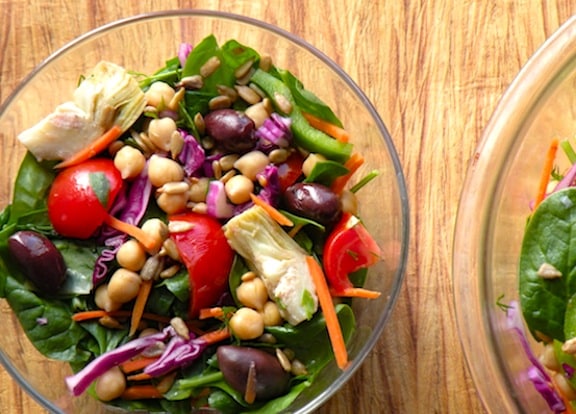
This salad should include lettuce, tomatoes, shredded onion, and at least one shredded raw cruciferous vegetable, such as chopped kale, red cabbage, nappa cabbage, arugula, watercress, or baby bok choy.
Use a variety of greens, including romaine, mixed greens, mesclun mix, arugula, baby spinach, Boston lettuce, and watercress.
For added veggies, choose from red and green bell peppers, cucumbers, carrots, bean sprouts, shredded red or green cabbage, chopped white and red onions, lightly sautéed mushrooms, lightly steamed and sliced zucchini, raw and lightly steamed beets and carrots, snow peas, broccoli, cauliflower, and radishes. I often add some frozen peas and beans to my salads too.
Add a healthy dressing (one that is nut and seed based). I usually make a huge salad, share it with family members, and have enough left over for later in the day or the next day. Remember, for superior health, the green salad is the main dish, not the side dish.
For inspiration, browse my vegan salad recipes!
2. Eat at least a half cup, but preferably closer to 1 cup, of beans a day.
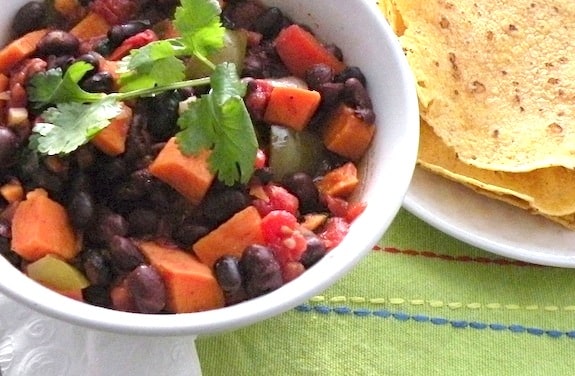
This means eating a bean burger, a bean loaf, or a veggie-bean soup or putting beans on your salad or in a stew or chili in the evening.
In our household, we almost always make a giant pot of veggie bean soup once a week. After eating the soup that day, I portion it into eight containers and refrigerate or freeze it so I can take it to work with me or use it when I need it.
Quick tip: Use some of the soup you made as a unique salad dressing base by adding some flavored vinegar and nuts. Blend in a high-powered blender until smooth.
3. Eat one large (double-size) serving of lightly steamed green vegetables a day.
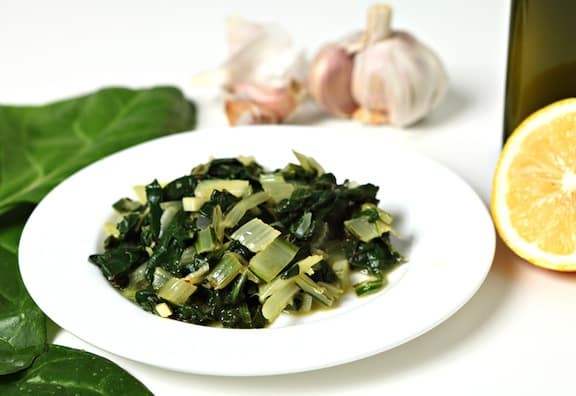
This means a bowl of asparagus, chopped kale with a delicious mushroom/onion sauce, green beans, steamed zucchini, bok choy, artichokes, cabbage, or collard greens.
Don’t overcook greens; thirteen minutes of steaming is plenty. The longer you cook them, the more micronutrients you burn off, which wastes the effects of phytochemicals.
Green vegetables need to be fully chewed (to the consistency of nearly liquid in your mouth) for you to fully benefit from their anticancer phytonutrients.
4. Eat at least 1 ounce of nuts and seeds per day if you’re female and at least 1.5 ounces of nuts and seeds per day if you’re male.
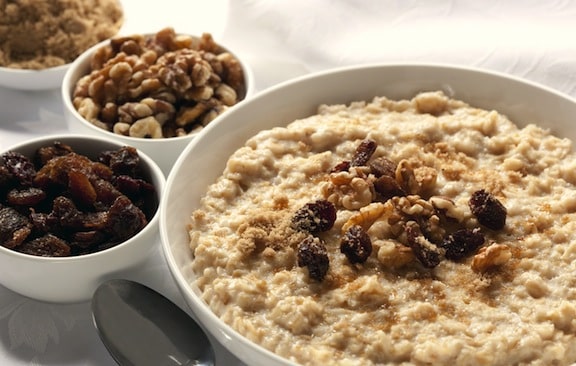
Remember, don’t use nuts and seeds as snacks. They are the healthiest way to take in fat with meals and demonstrate a powerful effect on extending the human lifespan. The fat from nuts and seeds, when eaten with vegetables, increases the phytochemical absorption from those veggies.
That’s why I typically recommend that nuts and seeds be part of your salad dressing, too. Also, at least half of this intake should be from walnuts, hemp seeds, chia seeds, flaxseeds, and sesame seeds because they have unique protective properties, such as lignans and omega-3 fatty acids.
Eating 3 to 4 ounces of nuts and seeds a day isn’t too much if you’re active and slim. There’s no problem with eating even more than 4 ounces of nuts and seeds per day if you’re an avid exerciser or athlete who needs the calories.
I have worked with professional football players and Olympic skiers who follow this diet style; obviously, they need lots more seeds and nuts, and other food too.
Eat nuts and seeds raw, or just lightly toasted, because the roasting process alters their beneficial fats. Commercially packaged nuts and seeds are also frequently cooked in oil and are heavily salted.
If you want to add some flavor, lightly toast seeds and nuts in a toaster oven on one low toasting cycle. This doesn’t deplete their beneficial properties.
Don’t toast to the point of dark browning, however, as this can cause carcinogenic compounds called acrylamides to be formed. You can also bake them in a 250°F oven for about fifteen minutes, or until very lightly browned.
5. Eat mushrooms and onions every day.
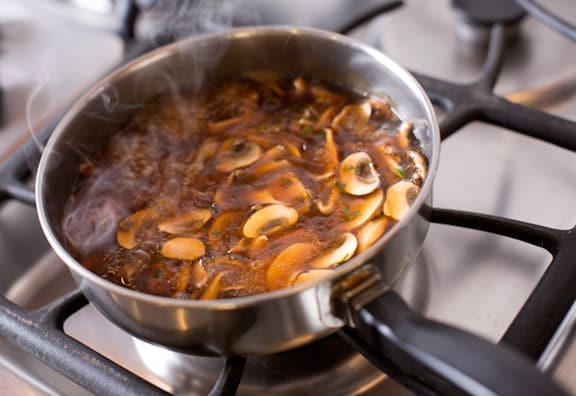
Both mushrooms and onions have powerful anticancer benefits. Mushrooms are better eaten cooked because some mushrooms contain a mild carcinogen called agaritine. It is gassed off during cooking.
Only the Agaricus genus of mushrooms—which includes the common white, brown, button, cremini, and portobello mushrooms—contains agaritine. Shiitake, chanterelle, enoki, morel, oyster, and straw mushrooms belong to different genera that don’t contain agaritine. But they should also be cooked to reduce the risk of any potential contamination with microbes.
It’s still not entirely clear whether agaritine is a health risk, but play it safe and cook most of your mushrooms with your other vegetables, or water-sauté them in a wok or other pan. Keep a container of cooked mushrooms in your fridge to add to salads and vegetable dishes regularly.
6. Eat three fresh fruits a day.
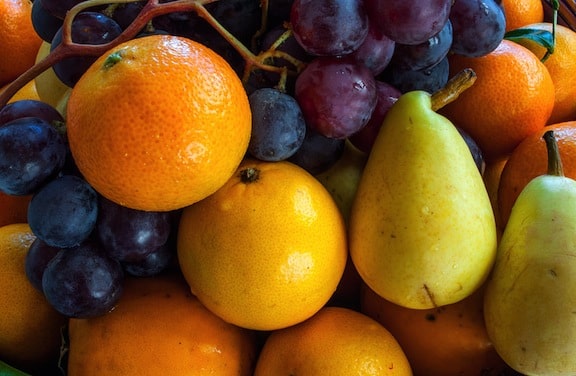
Fresh fruits aren’t just nutritious and delicious, they also protect against disease. The phytochemicals in fruits have anticancer effects, and berries have even been shown to protect the brain from dementia in later life. Try to eat one serving of berries or pomegranate a day as part of your total fruit intake.
When eaten with a meal, vegetables dilute and slow your body’s absorption of glucose and fructose, so it’s best to eat fruit as part of your vegetable-based meal, either mixed in with your salad or as a dessert.
If you’re physically active, you can certainly eat more than three fruits a day, but it’s still best to avoid fruit juice and too much dried fruit, such as dates, raisins, figs, and prunes, because they are calorically dense and could elevate your blood sugar if you eat them in large amounts.
When making a recipe or dessert that contains dried fruit for flavor and sweetness, limit the amount to 2 tablespoons per serving. That means one Medjool date or two Deglet Noor dates per dessert serving; otherwise, you could be consuming too much simple sugar.
That’s it. Six simple guidelines to follow.
That’s not so difficult to do, is it? Can you imagine what would happen if everyone in the United States followed these guidelines?
- We would stop the healthcare crisis in its tracks and save billions of dollars on medical expenses.
- We would save millions of lives from premature death.
- We would reduce rates of heart disease, stroke, dementia, and cancer by more than 80 percent.
- We would have less crime, and a more successful, intelligent, and productive workforce.
- We would have many fewer people in nursing homes, fewer stroke victims, and fewer elderly people suffering from dementia and unable to enjoy life.
Nutritarian Daily Checklist
Make copies of this chart and check off each point each day.
- Eat a large salad as the main dish for at least one meal.
- Eat at least a half cup, but preferably closer to 1 cup, of beans.
- Eat one large (double-size) serving of steamed green vegetables.
- Eat at least 1 ounce of nuts and seeds if you’re female and at least 1.5 ounces of nuts and seeds if you’re male. Half of them should be walnuts, hemp seeds, chia seeds, flaxseeds, or sesame seeds.
- Eat some cooked mushrooms and raw and cooked onions.
- Eat at least three fresh fruits.
More
For more tips on plant-based nutrition, make sure to browse VegKitchen’s Healthy Vegan Kitchen resources.


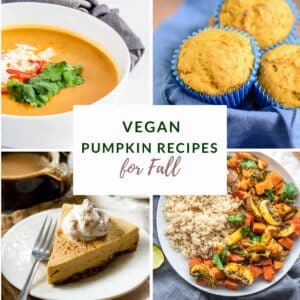
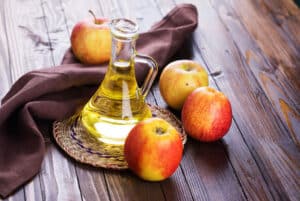
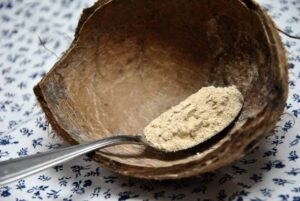
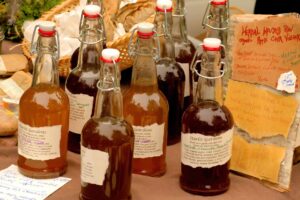
Deborah says
Many health sites dictate soaking seeds and nuts for up to 24 hours before consumption to get remove the enzyme inhibitors and minor toxins so why don't you?
Here's an example: http://www.raw-food-living.com/soaking-nuts.html
Nava says
I wonder if that applies mainly to raw nuts and seeds. Perhaps lightly toasting them accomplishes the same thing? Personally I enjoy crunchy lightly toasted nuts and seeds, rather than mushy soaked ones, but the latter are useful if you're going to be blending them into creamy sauces and such.
josette says
Yes, you are supposed to soak the nuts and seeds, but each one has a different soaking time. After the soaking you can dehydrate them or put them on the lowest setting in your oven to dry them. Store them in the freezer or fridge. The Blender Girl has a nice soaking chart in her book and maybe on her website.
Daniel McLaughlin says
Are non caffeinated and herbal loose leaf teas okay? What's your stance on coconut oil? Some say its good, others say stay away? Could you shed some light on wether the coconut is a foe or friend? Thank you!
Renauda McGrath says
Why isn't microwaving addressed in this info, or any other info I've read from Dr. Fuhrman? I've read that studies show microwaving ruins nutrients. Its odd that I can't find any advice from Dr. Fuhrman on this. What is your stand?
Nava says
I have mixed feelings. I would never cook nutritious veggies like broccoli and greens, and I've also read that it destroys nutrients. But I have to admit that I use the microwave occasionally as a warmer-upper and have done so for a very long time. And I've lived to tell the tale!
Newby says
Sure you've lived to tell the tale. Many have based their diets on fast food and they too are alive to tell the tale.....for now.
Laura says
Oh this is what I have needed. I have been eating a whole foods plant based diet for some time now but have trouble with constipation. Getting a basic guide of what to include is so helpful. I love the Forks Over Knives and Engine 2 plans but they are a bit "free" in structure - I need a little more of a checklist so I don't just eat all salad one day, all beans another day, all fruit another day. I know that sounds silly but I have a busy life and strangely a checklist of "don't forget" items is very helpful.
Laura says
Would also love to hear your thoughts on oils and particularly Coconut products in general. What "milks" do you use? This is generally a non-dairy eating plan, right?
Nava says
Hi Laura — I'm answering on my own behalf (Nava), not Dr. Fuhrman, who is the author of this helpful article. I basically use tiny amounts of olive oil for general purposes. I doubt I ingest more than a teaspoon per day all told. Personally, I'm not a fan of coconut products other than So Delicious Coconut Creamer for coffee. I just find the aroma and flavor cloying in food. And I'm suspicious of an oil that's rock-hard at room temperature. I could be wrong about this, but I'm just not a fan. As far as non-dairy milks, I mostly use almond milk, and for soups and such, rice milk. And I do believe that the goal of the nutritarian diet is to reduce or eliminate dairy. After all, nature formulated cow's milk specifically for calves, not humans ...I'm glad that Dr. Fuhrman's guidelines were helpful for you, and good luck!
Red says
I would love to do this type of eating I believe in it's wholesomeness.. but just cannot stomach beans. Don't like the taste, texture... aftertaste makes me gag a little... So I'm a little befuddled there.
I HAVE blended them in baked goods(as a flour replacement) - but that's probably not the best solution.
Blended soups are OK - but even then I seriously want to salt it to death just to get it down.
Any suggestions would be helpful!!
Ben Gessel says
Red, I have a few thoughts for you, about eating more beans, etc. The first train of thought is that there are at least a dozen different kinds of beans, more than you might realize. Whole Foods has a very wide selection of beans, including adzuki, kidney, mung, pinto, black, garbanzo, fava, navy and lima beans (among others), as well as organic soybeans/edamame and lentils-different colors of lentils even, to my recollection. Each of these beans is a little bit different. I have found that I like beans best in chili, tacos, stews, soups, salads, with brown and/or wild rice or quinoa, with meat (yes, not something to be eaten very often in sizable quantities, etc.), in curries/Indian food (lentils), with potatoes, and in other Mexican foods-burritos, etc. I can eat beans as they are, but yeah, they often need a bit more flavor to liven them up a little. Savory goes well with beans of course, as well as other herbs like chives, spices like paprika, cumin, turmeric, etc., and sautéed onions. Also, peas still technically count as a bean, as do, to a lesser extent, green beans, bean sprouts, etc. The important area of nutrition with beans, is the lean protein/fiber/healthy/slow burning carb arena, so eating a little more seeds, nuts, dark leafy greens, 100% whole grains, and a little wild caught fish/organic skinless poultry/eggs, etc. should take much of the need away for more considerable/regular bean consumption. They are not ideal substitutes... depending on what substitutes/how much of each food you use in place of beans, but they are better than other alternatives. And remember, with anything soy, it must be organic.
Ben Gessel says
One more thing Red. In Dr. Fuhrman's nutritarian pyramid, there are fairly wide ranges of percent of daily calories needed for the most important food groups-veggies, fruit, beans, and nuts/seeds/avocado. The daily percentage of calories needed from beans is between 10 to 40 percent, to my recollection. (I could be mistaken, but I think that's about right.) That 10 to, let's say... 15 percent of daily calories you need from beans (unless you are extremely active) can be easily met with a black bean, kidney bean, garbanzo bean, split pea or lentil soup, a lentil and kidney bean salad, hummus, Persian rice and Lima beans, chili, lentils and rice, or a bean burrito (healthy beans only mind you, be very careful of the fat/processed foods/added ingredients in microwaveable refried bean burritos, etc.). Best to make a burrito yourself. Hope this helps! (And by all means, eat beans with brown/wild rice, seasoned with savory, etc., throw in some sautéed mushrooms and onions with that, and I can guarantee you that you will have little trouble finishing your plate! (And getting seconds.)
Carolyne Spackman says
I had never heard of this program but have been vegan, mostly raw or fruitarian, for 4 years. A couple months ago I was trying to enter my foods on cronometer.com to make sure I was getting the right balance of nutrients. It turned out that I had to reduce my fruit portions slightly but add mushrooms (I was already having 1 to 2 large salads a day so I didn't change that) and Kombucha, seaweed, and occasionally and to my surprise beans into my diet in order to meet all the rda's for vitamins and minerals. I also started steaming greens, broccoli, and Brussels sprouts and eating them too to get enough of some minerals. Of course I still do my raw juices and smoothies. But what I have been eating the last 3 months has become very similar to what is recommended here. It's very interesting that I surfed in here somehow! Not saying I've morphed into a nutritarian since I haven't read any of these books (yet) but it is interesting that coming from a different direction, raw vegan rather than from standar American diet, you can still end up here when trying to find a way to be fully nourished without taking supplement pills.
molly says
Super helpful info. Thank you for posting 🙂
Carol says
Red... one other way to kill the aftertaste of beans is to use spices. Not just your typical whimps terragon or thyme, but things like jalapenos, thai chiles, tabasco sauce, siracha, cheyene and chili powder. Add a little Wasabi to a sushi bowl with rice, greens, and edemame or tofu. Having that lingering burn after a meal will feel more satisfying than the aftertaste of a bean dish.
schealer says
What about brwn rice, oatmeal and whole grains? Are they acceptable? Also, potatoes..?
Ray says
I have a question that maybe someone can help me with...
How do I measure the cup of beans we eat each day - do I measure cooked beans, or unsoaked beans?
Obviously it's a lot more beans if we're supposed to measure them before they have been soaked.
I love beans, they're so tasty and filling, so I'm hoping it's the latter 🙂
Oh, and is peanut butter OK to eat? On the jar the only ingredient listed is 100% roasted peanuts.
Thanks
Norah says
Ray - Measure the beans after they are cooked. And I believe peanut butter is OK in small amounts. It will count as a fat/protein.
1zumbalady says
I am very interested in making this change,but I have been allergic to all beans and nuts (except peanuts) since childhood. How can I participate if I can't eat the main food groups?
Nava says
Hello — that is a very tough quandary! I can't answer this, but you may be able to get more information from Dr. Fuhrman's web site, as he originate the nutritarian diet: https://www.drfuhrman.com/
Gayle says
Dr Fuhrman does allow limited wholegrains and potatoes according to his Nutritarian Pyramid.
Scott M. says
He recommends that you eat whole grain oats, limited potatoes, limited rice (brown or wild rice only) and no wheat.
Jen L. says
I definitely want to try this plan since I've been a vegan for 3 years and still am overweight. Although that was not my reason behind becoming vegan, I had hoped it would be a benefit. I can follow all of these steps except for one. I cannot eat onions and mushrooms! Something about the taste and/or texture. What should I have instead as a substitution?
Nava says
Hi Jen. It's certainly not pleasant to eat foods you don't enjoy! If you like other alliums, like scallions, leeks, and garlic, you can use more of those, but if you don't like these at all, perhaps use more bell peppers. Not the same, really, but these are great flavor boosters, and packed with vitamins. As for mushrooms, lots of people don't like them, but there's really no substitute — simply skip them. Lots of people have lived to ripe old ages without them, I'm sure!
Brimmage says
LOL you could tell this was written by an American, because the first advantage he listed for following his guidelines is "we could save money!".
MS GETHEALTHY says
My thoughts are leaning toward giving this life style a try. Many of the foods I eat anyway, but not in combinations as described by him. I'm not hearing when the 3 oz of fish/ chicken/ turkey fits in. I eat cauliflower rice with everything, since rice always causing me to gain weight. Is SOY ok? Edamame, burgers? Do I have to eat rice? I also don't like bananas,, how can I substitute? The onion substitution was helpful because, I tend be very gassy. Thanks for all the encouragement
Carol A Sweeney says
Sounds wonderful! Here is the glitch...people with thyroid issues must stay away from goigitren veggies like peppers, broccoli, and cauliflower. These veggies impact thyroid production.
Many of the veggies on this list are on my foods to avoid lists (for which I was
tested)for food intolerance because of my
DNA. That does not leave a lot for me to eat on a consistent basis. Many veggies create a LOT of gas because of intestinal flora. TAking probiotics to supposedly "correct" intestinal problems can create more problems like diarrhea.
Lauren says
I'm not an official expert but I've read a few of Dr. Fuhrman's books, so here is my 2 cents on a few of the questions above.
1) Deborah - I haven't seen Dr. Fuhrman recommend soaking nuts or seeds. He tends to be science-based, so maybe there just haven't been enough studies about the benefits of soaking? Here is some more info from his site on nuts: https://www.drfuhrman.com/learn/library/articles/39/nuts-and-seeds-essential-for-good-health-and-weight-loss
4) Daniel - Non-caffeinated herbal teas are OK. Oil is not recommended at all.
5) Renauda - Microwaving is OK for reheating but not for cooking.
18) Ray - The roasting process creates acrylamides (a carcinogenic compound) in peanuts. So it's better to substitute raw cashew or raw almond butter (see link above).
27) MS GETHEALTHY - I think his guideline is one serving per day of low- or un-processed soy, like edamame, tofu, tempeh, or soy milk. Soy is a bean and it's good to eat a variety of beans, not just one. More info here: https://www.drfuhrman.com/learn/library/articles/104/dont-fall-for-the-myths-about-soy
Thanks, Nava, for your great site and delicious cookbooks.
Glen says
This is a great way to eat, but only IF one also consumes at least a few animal products each week (especially fish) or take supplements for Vit. B12, Vit. K2, EPA/DHA, and creatine. That's because its virtually impossible to get sufficient amounts of these vitamins and nutrients from plants alone. Multiple studies have shown this, and Fuhrman agrees in his books. If you are deficient in them, you more than defeat the purpose of the rest of the diet, since you will have a vastly increased chance of heat disease, dementia, and other serious conditions. Supplementing magnesium (either orally, or with topical Mg oils or Epsom Salt soaks) is also a good idea, because modern farming methods have largely depleted the soil of it, and Mg deficiency can foster heart arrythmias, cramps, and other ailments.
Also, the author should stress not only what is good to eat, but what should be largely avoided or eliminated to maximize health and minimize risk of many diseases. That includes trans fats, added salt, sugars and other sweeteners and refined carbs (white bread, cake, donuts, chips, etc), and all processed foods, most of which are loaded with the above, as well as preservatives, dyes, and other harmful additives and chemicals.
Glen says
I also meant to add dairy products to the list of foods to avoid, since as many studies have shown, and Fuhrman agrees, milk, cheese, and other dairy products (even low fat versions) increase risk of cancer and other diseases. Better alternatives (besides water) include unsweetened soy, almond, and coconut milk, widely available these days in most stores. And of course meat (by which I mean beef, pork, poultry, and other animal flesh foods) should be eaten only in small quantities, with the caveat that if they are largely or entirely eliminated, one needs to supplement B12 and K2, since these are critical vitamins that cannot be obtained in sufficient quantities from plants alone.
Nava says
Hi Glen — thanks for your comments, but many practitioners of the vegan diet would respectfully disagree that any animal products are needed at all. Many studies have born this out. That said, making sure to get sufficient B12 is very important. I use nutritional yeast, not pills, and my yearly checkups show that my levels are just perfect. And all the junk foods you mention in your first post, of course, no one needs these no matter what their dietary inclination is! Americans, especially, consume way too much sugar and white starches.
Glen says
Nava, I did not say one must eat animal products; I just cautioned that if one did not eat any, one was in danger of having a number of deficiencies in B12, K2, EPA/DHA and other nutrients unless supplements were taken. If you've been able to maintain good B12 levels from nutritional yeast, fine. Vegans still need to supplement or find ways to get enough K2 and EPA/DHA, since it's virtually impossible to get enough of those from plants alone (although algae can help with the latter). Some vegans think (based on old research) that they can get enough EPA and DHA from the ALA Omega-3s in foods like Flax and Chia seeds, but recent studies show that very little is converted into EPA and DHA. These specific fatty acids are vital for heart and brain health, and consequences of deficiencies in them (as well as B12 and K2) can be dire, even lethal, as Fuhrman and others document. For example, see pp 61-69 of his book _The End of Dieting_.
Glen says
I should also add, in regards to Nara's use of nutritional yeast as a B12 source, that one has to be careful about the kind of nutritional yeast one uses, since (among other concerns) not all versions have much B12. Some also believe that seaweed (marine algae) is a good source of B12, but it's not. For more info see: http://veganhealth.org/b12/vegansources
Glen says
Don't mean to belabor the B12 issue, but another thing worth considering is that according Fuhrman says that checking blood levels of B12 alone is not sufficient, because "your methylmalonic acid (MMA) mist be checked to accurately gauge if the level of B12 in your body is enough for you." (Eat to Live p. 289). Also see: http://www.easy-immune-health.com/methylmalonic-acid.html
nullymer says
Microwaves are perfectly fine to use and certainly do not deplete nutrients. That's just a silly superstition, microwaves simply create heat and nothing more. Dr Mcdougall addressed the microwave concern in one of his newsletters. Also, frozen vegetables actually have more nutrients than fresh vegetables do because they haven't aged as much, they're flash frozen at their most fresh state. The idea that something isn't healthy simply because it's newer technology is a common bias people have, but the truth is natural does not necessarily mean better or most optimal.
Sue says
I would like to follow this eating plan, however, I would like to know how to gain weight on this eating plan. It may sound strange but my goal is to gain 8 pounds.Any suggestions would be appreciated. I do love beans, all veggies, fruits, nuts and seeds but how to gain weight is challenging. Yes, my doctor says nothing wrong with me. I am 65 inches and weight 118 and am 64 years old.
Nava says
Hi Sue — see our article on gaining weight healthfully on a vegan diet. Hopefully you'll find something helpful there: http://www.vegkitchen.com/nutrition/5-ways-to-healthfully-gain-weight-on-a-vegan-diet/